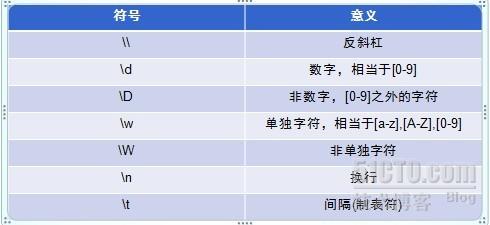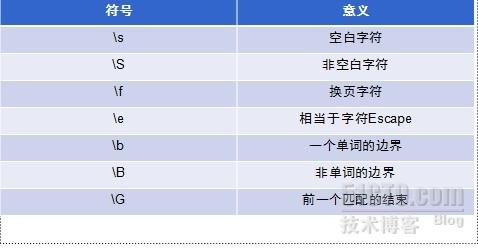正則表達示
瞭解正則表達示,首先要明白爲什麼需要正則表達示。
正則表達示是一門自然語言,並不單純的依賴於某一種語言而存在,
在程序開發的過程當中,我們經常需要處理一些字符串,比如匹配呀,查找,替換,判斷字符串的情況,如果單純的僅僅用編碼的方法一個一個來拼接,或者其他的方式來處理,我們需要浪費的太多的時間和精力,有了它,使得我們字符串處理簡單而高效。
首先我們來了解一下在正則表達式中需要用的替換字符
1、 .(點號,匹配所有的字符) [](匹配指定的字符這個是單個字符的匹配) 括號”()“是[]的擴展,可以匹配多個,用|符號隔開 | (或) {}(來說明字符出現的次數) ^(表示相反的字符)
2、說明字符出現次數的符號有
*(0次或多次) +(1次或多次) ?(0次或一切) {m} 指定的M次 {n,m} 指定的M-N次
3、快捷符號:
4、敏感詞彙的替換(replaceAll()等字體串中的方法就自己去體會了)
a.交集和並集的例子
public class regex3 {
/** @param args */
public static void main(String[] args) {
// TODO Auto-generated method stub
// 字符串的交集 並集
String[] str = { "A1", "B3", "E4", "F3", "G5", "M9" };
String reg = "[A-F&&E-M][0-9]";// 交集
for (String string : str) {
if (string.matches(reg)) {
System.out.println(string);
}
}
System.out.println("^^^^^^^^^^^^^^^^^^");
String reg1 = "[A-B[G-M]][0-9]";// 並集
for (String string : str) {
if (string.matches(reg1)) {
System.out.println(string);
}
}
String str2 = "*";
String reg2="\\D";
if(str2.matches(reg2)){
System.out.println(str2);
}
}
}
b.通過Pattern來匹配的郵箱例子:
public class Regex2 {
/** @param args */
public static void main(String[] args) {
// TODO Auto-generated method stub
String mystr = "The theatre is the greatest from of live"+
"entertainment according to thespians.";
String reg1 = "the[a-z]";
//截取包含正則表達式的字符串
Pattern pattern = Pattern.compile(reg1);
//首先把正則表達示編譯成一個pattern對象
Matcher matcher = pattern.matcher(mystr);
//根據樣式對象pattern針對這字符串生成一個掃描器matcher
while(matcher.find()){
System.out.println(matcher.group());//用group用來得到匹配的字符
}
String str1="[email protected]";
parse(str1);
}
private static void parse(String line) {
Pattern p = Pattern.compile("[\\w[.-]]+@[\\w[.-]]+\\.[\\w]+");
Matcher m = p.matcher(line);
while(m.find()) {
System.out.println(m.group());
}
}
}
c.敏感詞彙的替換
public class Regex5 {
/** @param args */
public static void main(String[] args) {
// TODO Auto-generated method stub
File file = new File("a.txt");
try {
BufferedReader fin = new BufferedReader(new FileReader(file));
String str = "";
String regex = "國民黨";
while ((str = fin.readLine()) != null) {
Pattern p = Pattern.compile(regex);
Matcher m = p.matcher(str);
StringBuffer sb = new StringBuffer();
while (m.find()) {
m.appendReplacement(sb, "vickyi");//"vickyi"用來替換"國民黨" 把找到的替換放到SB中
}
m.appendTail(sb);
System.out.println(sb.toString());
}
} catch (Exception e) {
// TODO Auto-generated catch block
e.printStackTrace();
}
}
}
正則表達示是一個很神奇的東西,在有些地方用得好的話,可以省去好多的腦力活動。深入的研究一下正則表達示很有必要。


